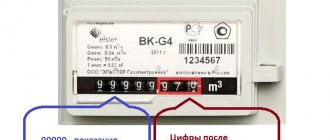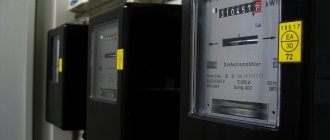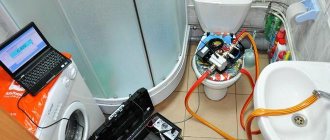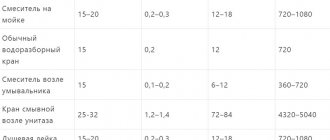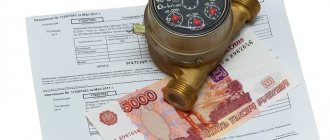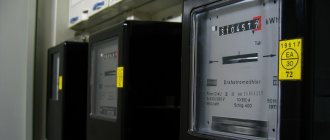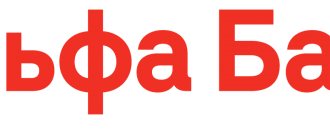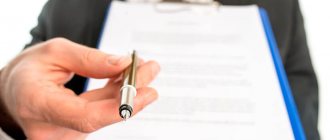Why is it necessary to install water meters?
Payment for water supply services is carried out in two ways:
- according to standards - average consumption indicators, depending on the number of units registered in the apartment and the tariffs approved in the region. When calculating standards, a single methodology is used for the entire country; the difference lies in the size of the increasing coefficient and tariff, depending on the individual characteristics of the region;
- according to individual metering devices - the installed meter determines the actual amount of consumed resources that are subject to payment.
Savings when installing a meter
Considering that a multiplying factor is used when calculating standards, as well as the fact that when a meter is installed, the consumer pays only for the water actually used, the second payment method is preferable. A comparative analysis shows that the bill amounts when paying by water meter are two times or more less than those calculated according to the standards.
Procedure for submitting water meter readings
If previously the consumption of water and other utilities was calculated based on average indicators, then in the era of personal metering devices, citizens pay only for real consumption.
To do this, payers inform the service provider of the current readings of water meters so that payment is made only for the difference between the figures of the previous period and the current one.
There are several ways to transmit water meter readings:
- Enter the testimony in a special column of the payment document that was received by mail.
- Transfer of readings is possible using the phone number indicated on the receipt. You need to contact the operator and dictate to him the numbers that are on the meter at a given time.
- Meter readings are received on a website created specifically for Moscow residents - mos.ru. Representatives of various districts of the capital (Southern Administrative District, South-Eastern Administrative District, Eastern Administrative District, South-Western Administrative District, etc.) can, without leaving home, solve any problems and receive advice and services from various government agencies.
Let's look at the last option in more detail.
Authorization/Registration in the portal’s personal account
To enter your mos.ru personal account through Moscow government services to transmit water meter readings, you must register or, if you have a valid account, log in.
Registration takes a minimum of time, but gives the user access to hundreds of electronic services. You will need to come up with a username and password to log in, and also enter the following data:
- FULL NAME.;
- phone number;
- E-mail address;
- SNILS number.
Subsequently, to log in you will need to enter either your insurance certificate number or your login.
Select a service on the website
To start transferring meter readings, follow the link and click the “ Get service ” button, as in the picture.
After clicking the button, you will be redirected to a form for filling out your personal information.
Indicate the payer code and apartment number
In order to correctly enter the readings that are on your water meter, you need to pay attention to the correct entry of the payer code and apartment number. This data is the individual's identifier for the service provider.
If you do not know your payer code, you can find it out by looking at your own receipts (photo below).
The system will offer to save the apartment address and name - click “ Save ”.
Entering readings
To add readings, you just need to click on the “ Add ” button and enter the desired digital value.
Data transfer deadlines
The rights and obligations of utility organizations and consumers are approved by Government Decree No. 354, adopted in May 2011 and establishing the basic rules for the provision of these services to the population.
Document for downloading and reading the resolution: Decree of the Government of the Russian Federation No. 354
According to the specified document, the transfer of information for the current month must be carried out no later than the 26th day, and not after the end of the reporting period.
We recommend: Automatic switches for electricity meters
How to take water meter readings
Most of the problems can arise from the difficulty of seeing the instrument readings. Therefore, it is not recommended to “sew” meters deep into a plasterboard box, because sooner or later they will have to be replaced. Arm yourself with a flashlight and good glasses, and write down the device data, rounding to one decimal place.
An example of the location of information on the meter
There may be such an option. If you do not have special markings: a meter for cold water usually has a blue rim, and a hot one with a red rim, check the supply pipe itself; by its temperature it will be easy to understand which meter is which.
But if your water is turned off, or it does not heat up, you will have to open the tap and see which of the devices has the wheels spinning when turned on
Carefully write down the data in a notepad, next to it indicate the date the readings were taken. Ideally, you should keep a separate notebook so that you can compare data if necessary.
Advice! Make sure there are no water leaks in your house or apartment. This can threaten not only troubles with neighbors, but also unnecessary expenses.
You can check the location of the water leak in a simple way: close all the taps and see if the flow is going
What water meter readings need to be recorded?
Be sure to record your expenses. Sometimes a simple air lock can cause unnecessary expenses. In this case, the meter will spin as if you are consuming water.
How to check the accuracy of water meters
To do this, you need to take a large container, maybe a bucket. Or two and drain the water there. The main thing is to notice in advance how much water is poured. Don't worry, you can use it, for example, to fill a bubble bath. Before the procedure, take meter readings. And then check how much the data has changed. This way you will check the functionality and accuracy of your metering devices. The main thing is not to get burned and not to drown your neighbors.
If the readings are higher, immediately run to the nearest plumbing store for a new device and send a request to the management company to change the device
Related article:
Magnet for water meters : is it worth it or not to get involved, what magnet is used, whether magnetization can be determined, how anti-magnetic protection works, the risks of using a neodymium magnet and safe ways to stop the meter - read the publication.
Methods of providing information
The methods of providing information depend on the infrastructure capabilities of a particular locality, the rules established in the region, and the provisions of the agreement concluded by the consumer with the resource supplier.
When transmitting data, in addition to water meter indicators, the consumer indicates:
- Full name of the payer;
- location of the metering device, with the full address of the apartment;
- personal code of the consumer (put down on the invoice);
- identification numbers of metering devices assigned by the manufacturer.
Testimony can be transmitted in the following ways:
- telephone call is the most common form of data transfer, but not always convenient. Connection problems often arise due to heavy line congestion. As a result, the caller has to communicate with the answering machine for a long time, after which the line is disconnected. Telephone numbers of the water supply company are usually specified in the service agreement. This information can also be clarified from employees of the management company or from the media;
- By SMS message – information is sent in the prescribed form to a code number. A separate message is transmitted for each of the water meters;
- via the Internet - the consumer registers in the program, a personal page is created with an individual login, protected by a password. The readings are entered no later than the set date and saved;
- via a mobile application - a form of transmission via the Internet, available for portable gadgets. Requires installation of a special application;
- by email;
- by directly visiting the company or sending a paper form - some organizations place special boxes for collecting testimony.
Methods of transmitting readings for the city - Moscow
- Unified service department -.
- Mobile application - downloaded from the official website.
- City service portal – Login to your personal account.
The possibility of data transfer is offered by the official portal of the State Service. If a consumer has difficulties using the Internet service, assistance is provided by MFC employees. This simplifies the task and saves time.
The specific data transfer method depends on the capabilities available in your particular region.
Method of transmitting readings via the Internet:
What to do if you forgot your registration details
If you have forgotten your data, we use the service to recover your password.
- Select the inscription “forgot your password?”.
- It is located under the Login button.
- A telephone number, email address will be required, and in cases of a standard or confirmed entry, SNILS will be required.
- Receive a message with a numeric code to reset your data.
- We introduce it within 5 minutes.
- Then you need to come up with a new password and write it down.
If recovery fails, you can contact the service center. Addresses, depending on the city, are all provided on the password recovery page in the “Service Center” tab.
What happens if the data is not transferred in a timely manner?
According to paragraphs. 58 – 60 of the above government resolution No. 354, if the testimony is not reported within the prescribed period, charges for the provision of services are made in the following order:
- For three months, the amount is determined based on the average previous expense over the last six months. After receiving the data, the value is recalculated;
- Starting from the fourth month, the consumer will receive an invoice with the amount determined according to the standards applicable to payers without individual metering devices.
We recommend: How to register an electricity meter
Considering that the amount according to the standards significantly exceeds that calculated by the water meter, the consumer should not forget about the need to timely transmit meter readings, otherwise he will have to pay much more than usual.
What to do if you receive a large bill due to failure to provide evidence
If for some reason the consumer has not reported water meter data for more than three months and has received a huge water bill, the following options are possible:
- Pay the bill, then contact the water supply company, providing the necessary data with an application for recalculation and confirming your identity with a civil passport. After clarification of the readings, the amount is recalculated. The overpayment goes towards future deductions;
- Contact the city water utility without paying the bill received. If the review of the application is positive, the amount will be recalculated.
The current rules suggest that the payer must transmit data based on water meter readings at least once every three months in order not to pay more than the actual volume consumed.
He reported the hot water meter readings incorrectly and entered electricity readings instead of water.
24. If there are gas metering devices, the volume of supplied gas is determined based on the readings of the gas metering device (unit).
25. Determination of the volume of gas consumed is carried out according to the readings of the gas meter, subject to the following conditions:a) gas metering devices are used, the types of which are included in the state register of measuring instruments;
b) the seal(s) installed on the gas meter by the manufacturer or the organization that carried out the last verification, and the seal installed by the gas supplier at the place where the gas meter is connected to the gas pipeline, are not broken;
c) the deadline for the next verification, determined taking into account the frequency of its implementation, established by the Federal Agency for Technical Regulation and Metrology for each type of gas metering devices approved for use on the territory of the Russian Federation, has not arrived;
d) the gas meter is in good condition.
26. The volume of gas consumed according to the readings of a gas meter that does not have temperature compensation is determined as the difference in the readings of the gas meter at the beginning and end of the reporting period, multiplied by the temperature coefficient (the coefficient of reduction to standard conditions), approved for such types of gas metering devices by the Federal Agency for Technical Regulation and Metrology.
27. Determination of the volume of gas consumed according to the gas meter readings is carried out from the day the gas supplier installs a seal at the place where the gas meter is connected to the gas pipeline.
Installation of a seal at the place where the gas metering device is connected to the gas pipeline is carried out if the gas metering device is in good condition and there is a safety seal on the gas metering device from the manufacturer or the organization that carried out the last verification.
28. In the event of damage to the integrity of any of the seals specified in subparagraph “b” of paragraph 25 of these Rules, or a malfunction of the gas meter, about which the subscriber notified the gas supplier on the day such a malfunction was discovered, the volume of gas consumed is determined in accordance with gas consumption standards for the period from the date of notification until the day following the day of restoration of the seals, including the installation of a seal at the place where the gas meter after repair is connected to the gas pipeline.
If damage to the seals or a malfunction of the gas meter is revealed as a result of an inspection carried out by the gas supplier, the volume of gas consumed is determined in accordance with gas consumption standards for the period from the date of the last inspection to the day following the day the seals were restored, including the installation of the seal at the place where the gas meter after repair is connected to the gas pipeline, but no more than 6 months in advance.
29. Dismantling of gas meters for verification or repair is carried out by the organization with which the subscriber has entered into an agreement on the maintenance of in-house or in-apartment gas equipment. Dismantling is carried out in the presence of the gas supplier, who takes readings from the gas meter and checks the integrity of the seals at the time of dismantling the gas meter.
30. The volume of gas consumed for the period from the day the gas meter is dismantled to send it for verification or repair and until the day following the day the seal is installed at the place where the gas meter is connected to the gas pipeline after verification or repair, but not more than 3 months in a row, is determined based on the volume of average monthly gas consumption by the consumer, determined by the gas meter for a period of at least one year, and if the period of operation of the gas meter was less than one year - for the actual period of operation of the gas meter. After the specified 3-month period, the volume of gas consumed for each subsequent month up to the day following the day of installation of the seal at the place where the gas meter is connected to the gas pipeline after verification or repair is determined in accordance with gas consumption standards.
31. If the subscriber, within the period established by the contract, has not provided the gas supplier with information about the readings of the gas meter, the volume of gas consumed for the past billing period and before the billing period in which the subscriber resumed providing the specified information, but not more than 3 months in a row, is determined based on from the volume of average monthly gas consumption by the consumer, determined by the gas meter for a period of at least one year, and if the period of operation of the gas meter was less than one year - for the actual period of operation of the gas meter. After the specified 3-month period, the volume of gas consumed for each subsequent month up to the billing period in which the subscriber resumed submitting the specified information is determined in accordance with gas consumption standards.
Determination of the volume of gas consumed according to the readings of the gas meter is resumed from the day following the day of the inspection carried out by the gas supplier at the request of the subscriber.
If the determination of the volume of gas consumed according to the gas meter readings was not resumed from the beginning of the billing period, then for the elapsed days of the billing period, the volume of gas consumed is determined in accordance with gas consumption standards in proportion to the number of such days. In the specified billing period, the total volume of gas consumed is equal to the sum of the volume of gas consumed, calculated taking into account gas consumption standards, and the volume of gas consumed, as determined by the readings of the gas meter.
If the subscriber notifies the gas supplier in advance about the failure to provide information about the readings of the gas meter due to the fact that all citizens living in the residential premises (residential building), the gas supply of which is provided in accordance with the contract, will be absent from this place of residence for more than 1 month, the provisions of this paragraph do not apply.
32. If subscribers (individuals) do not have gas meters, the volume of gas consumption is determined in accordance with gas consumption standards. Standards and norms for gas consumption are approved in the manner established by the Government of the Russian Federation.
33. Gas consumption standards are established for the following types of consumption:
a) cooking;
b) heating hot water in the absence of a centralized hot water supply (using a gas water heater, and in its absence, using a gas stove);
c) heating of residential premises in apartment buildings, residential premises and premises for auxiliary use, intended to satisfy citizens’ household and other needs related to their residence in residential buildings;
d) heating of non-residential premises in apartment buildings and premises in outbuildings of households;
e) keeping farm animals and poultry on a private farm.
34. The gas consumption rate is the average monthly gas consumption for the following purposes:
a) cooking and heating water in the absence of a centralized hot water supply - per 1 person per month;
b) heating of residential premises in apartment buildings and residential buildings - per 1 sq. meter of total area of the specified premises per month;
c) heating of non-residential premises in apartment buildings, auxiliary premises in residential buildings and premises in outbuildings of a household - per 1 cubic meter. meter of heated room volume per month;
d) preparation of feed and heating of water necessary for keeping farm animals and poultry on a private farm - per 1 animal or bird of a certain species, respectively.
35. The volume of gas consumed, determined in accordance with gas consumption standards, in the billing period is calculated in the following order:
a) when using gas for cooking and heating water using gas appliances - as the product of the number of citizens living in a residential area and the established gas consumption standard for the corresponding type of consumption;
b) when using gas for heating residential premises, including auxiliary premises in an apartment of an apartment building - as the product of the total heated area and the gas consumption standard established for these purposes;
c) when using gas for heating non-residential premises in apartment buildings, auxiliary premises in residential buildings and premises in outbuildings of a household - as the product of the total volume of these premises and the gas consumption standard established for these purposes;
d) when using gas for preparing feed and heating water necessary for keeping farm animals and poultry on a private farm - as the sum of the products of the number of animals and birds of a certain type and the gas consumption standards established for these types of animals and birds.
36. If the actual connection of the gas pipeline included in the in-house gas equipment to the gas distribution (connected) network was not carried out from the first day of the billing period, the volume of gas consumed is determined in proportion to the number of days in the billing period after the specified connection, including the day of connection.
37. The volume of gas consumed during the billing period by a subscriber living in a room in an apartment (residential building) and determining the payment for gas consumed according to the readings of an intra-apartment (common house) gas meter is calculated as the product of the volume of gas consumed according to the readings of this device and a coefficient defined as :
the share of the living area of the room in the heated total area of the apartment (residential building) - in the presence of individual heating using gas appliances;
the share of the number of citizens living in a room in the total number of citizens living in an apartment (residential building) - in the presence of centralized heating.
38. The volume of gas consumed when used for several types of consumption is calculated by summing the volumes of consumed gas used for each type of consumption.
39. Depending on the method of processing payment documents established by the contract when paying for supplied gas, information about the volume of gas consumed is indicated by the subscriber in the payment receipt or communicated to the gas supplier in the manner provided for in the contract.
Additional technical features
Modern technologies offer opportunities that allow you not to think about transmitting readings and even the process of taking data.
Many manufacturers offer for sale water meters equipped with devices that remotely transmit readings to centralized metering systems of utility organizations. Such metering devices are more expensive, but such technical means are especially relevant for busy people or those who are away from home for a long time and are unable to regularly report water meter readings.
If the technical availability of the water supply company requires the use of such systems, after purchasing and installing a modern water meter, the readings will be reported automatically, without consumer intervention and direct control by the utility organization. A visit from a water utility representative will only be required when the water meter verification period has expired.
The consumer should not forget about his responsibilities stipulated by the current rules for the provision of public utilities and provide water meter readings in a timely manner so as not to overpay for unused resources.
How to rewrite instrument readings
First you need to find out which device shows the flow of cold water and which hot. The simplest solution: turn on the cold water tap and see which meter works. Accordingly, the other shows the hot water consumption.
To avoid confusion in the future, you can mark them with electrical tape or a marker. You should not pay attention to the colors of the counters. Now they are installed regardless of the characteristics of the water.
Please note that the counter has 8 digits. 5 numbers are black and 3 are red. The red numbers indicate the consumed liters; we do not take them into account when transmitting data readings.
The black numbers show consumption in m3; these are the ones we transfer to the organization to account for resource consumption. If several meters are installed, the water readings are summed up, hot water is separated from cold water.
